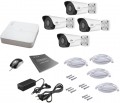Camera model
A model of pointed cameras supplied with a video surveillance kit. Knowing this data, you can find detailed information on the cameras and clarify their characteristics. Also, if you buy additional cameras of the same model, you don't have to worry about compatibility.
Matrix size
The physical size of the sensor in the pointed cameras is diagonally, in inches (fractions of an inch).
The larger the sensor, the less prone it is to noise, the better image quality it can provide, and the better it is suited to low light conditions. This is due to the fact that each individual pixel gets more light, because. on a large matrix and individual dots are larger. On the other hand, large matrices are more expensive.
Number of megapixels
Sensor resolution of pointed cameras in megapixels (millions of pixels).
Higher resolution allows you to get a more detailed "picture". However, increasing the number of megapixels without increasing the sensor size can result in poor overall image quality and noise, especially in low light. Therefore, in itself, the high resolution of the matrix does not guarantee high quality shooting.
Recording resolution
The maximum frame resolution in which the complete recorder can record video if all video channels are involved in operation. In fact, we are talking about the highest resolution in maximum load mode; if some channels are idle, some models allow higher resolutions. However, it is customary to indicate this parameter in the specifications - it most accurately characterizes the capabilities of the device.
As for the resolution itself, the higher it is, the more detailed the image is; on the other hand, such video requires significant processing power and capacious storage drives, which affects the final cost of the equipment.
Popular maximum frame resolutions in which modern recorders record:
HD (720),
Full HD (1080),
Quad HD,
Ultra HD (4K).
Frame rate
The highest frame rate at which the complete recorder can record at full load when all video channels are used. In other words, this is the guaranteed maximum frame rate that can be achieved at any load level (with some channels idle, the number of frames per second may be higher, but not necessarily).
The higher the frame rate, the better fast movement will be captured, the less blurry objects in such scenes will turn out. On the other hand, this indicator directly affects the cost of equipment and the amount of memory occupied by the footage. For video surveillance systems, an indicator of 24 fps is currently considered the minimum necessary, 50 – 60 fps is not bad, and in the most advanced registrars this number can reach 120 fps.

